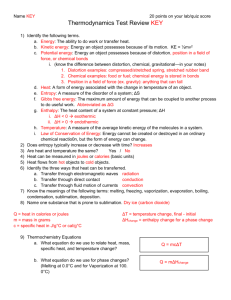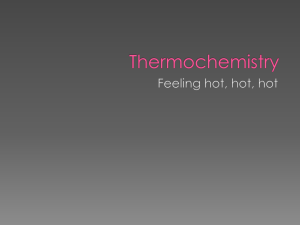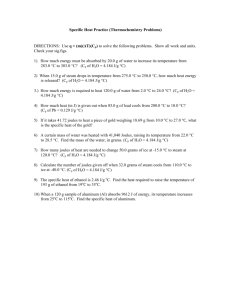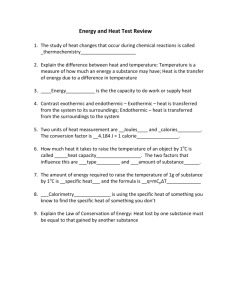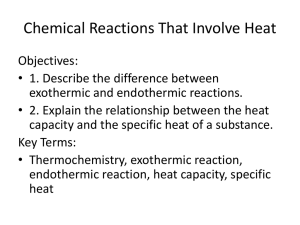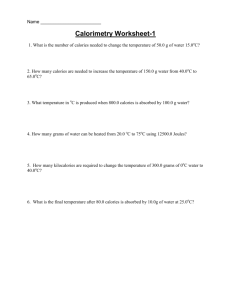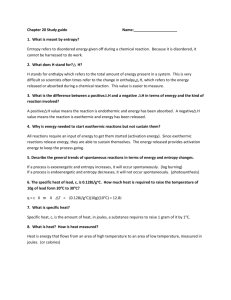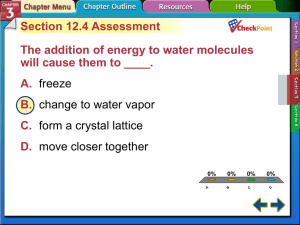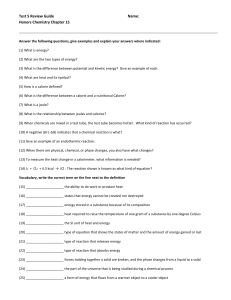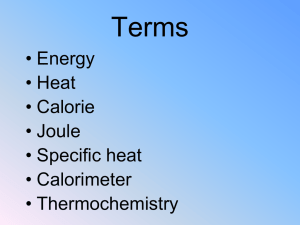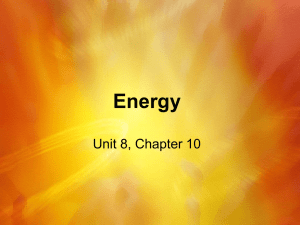Chapter 10
advertisement
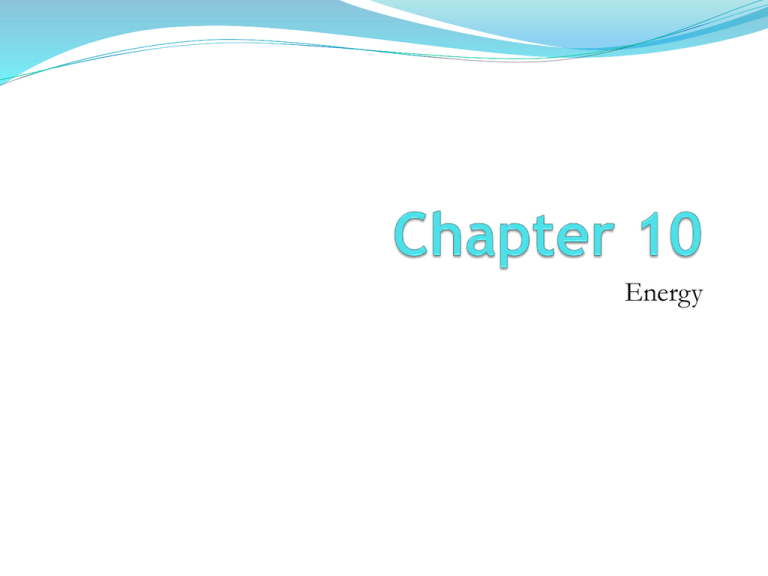
Energy 10.1 The Nature of Energy Energy: the ability to do work or produce heat Potential energy (store energy): energy due to position or composition Kinetic energy (motion energy): energy due to motion of the object and depends on the mass of the object and its velocity KE = ½ (mv2) Law of conservation of energy: that energy can be converted from one from to another but can be neither created or destroyed. Energy of the universe is constant The nature of energy Work: force acting over a distance W = F/d State function: property of the system that changes independently of its pathway Which of the following are state functions, and which are not The temperature of an ice cube The volume of an aerosol can The amount of time required for a 10 mi bike ride 10.2 Temperature and Heat Temperature: is a measure of the random motions of the components of a substance E.g H2O molecules move rapidly in hot water than in cold water Heat: a flow of energy due to a temperature difference Tfinal = average temp from mixing (hot & cold temp) 10.3 Exothermic and Endothermic Process System – everything we focus on in experiment Surroundings – everything other the system exothermic (energy flows out of system to surrounding (via heat) endothermic ( energy flows into system from surrounding (via heat) Examples Identify whether these process are exothermic or endothermic Your hand gets cold when you touch ice The ice melts when you touch it Propane is burning in a propane torch Two chemicals mixing in a beaker give off heat 10.4 Thermodynamics Is the study of energy. First law of thermodynamics: the energy of the universe is constant Internal energy – energy of the system ∆E = q x w ∆ => change in the function q => represents heat W => represents work 10.5 Measuring Energy changes calorie: the amount of energy (heat) required to raise the temperature of one gram of water by 1oC 1Calorie = 1000 calories Joule (J) – SI unit 1 calories = 4.184 joules Converting Calories to Joules Express 60.1 cal of energy in units of joules How many calories of energy corresponds to 28.4 J? Specific heat The amount of energy required to change the temperature of one gram of a substance by 1oC Denoted as s Heat required = specific heat x mass x change in temp q = s m ∆T Calculating Energy Requirements Determine the amount of energy (heat) in joules required to raise the temperature of 7.40 g water from 29.0oC to 46.0oC A 5.63 g sample of solid gold is heated from 21oC to 32oC. How much energy in Joules and calories is required? A sample of gold requires 3.1 J of energy to change its temperature from 19oC to 27oC. What is the mass of this sample of gold A 55.0 g aluminum block initially at 27.5oC absorbs 725 J of heat. What is the final temperature? 10.6 Enthalpy Heat of reaction (∆H) = the amount of heat that being absorbed or release by a given reaction ∆Hp = heat Enthalpy When 1 mol of methane (CH4) is burned at constant pressure, 890 kJ of energy is released at heat. Calculate ∆H for a process in which a 5.8 g sample of methane is burned at constant pressure The reaction that occurs in the heat packs used to treat sports injuries is 4Fe(s) + 3 O2(g) 2Fe2O3(s) ∆H= -1652 kJ How much heat is released when 1.00 g of Fe(s) is reacted with excess O2(g) Entropy Entropy (S) – measure of disorder or randomness Randomness increase -> S increases Sgas> Sion >Smolecule>Ssolid Ssolid = 0 E.gH2O(s) H2O (l) H2O (l) H2O (g) H2O (g) H2O (l) S=+ S=+ S=- 2nd law of thermodynamic: the entropy of the universe is always increasing
